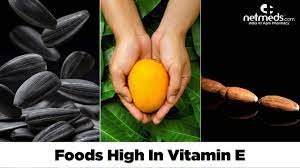Wellhealthorganic.com/vitamin-e-health-benefits-and-nutritional-sources

Welcome wellhealthorganic.com/vitamin-e-health-benefits-and-nutritional-sources to our latest blog post where we’ll be discussing one of the most important vitamins for your body: Vitamin E. You’ve probably heard about this vitamin before, but do you know why it’s so crucial? In this article, we’ll dive into the different forms and sources of Vitamin E and provide insight on its functions in the body. We’ll also highlight deficiency symptoms to watch out for as well as toxicity symptoms that can occur with excessive intake. So sit back, relax, and get ready to discover everything you need to know about Vitamin E!
What is Vitamin E?
Vitamin E is a fat-soluble vitamin that plays an essential role in maintaining the overall health of your body. There are eight different forms of Vitamin E, but alpha-tocopherol is the most biologically active and commonly found in supplements and fortified foods.
One fascinating fact about this vitamin is that it acts as an antioxidant, which means it helps protect cells from damage caused by free radicals (highly reactive molecules). These free radicals can harm DNA, proteins, and lipids in our bodies if not neutralized by antioxidants like Vitamin E.
While many people think of Vitamin E as just one nutrient, it’s actually a group of compounds with similar chemical structures. This diverse range makes them useful for various bodily functions such as immune system function, skin health maintenance, wound healing processes and much more.
Our bodies cannot produce Vitamin E on their own; we have to obtain it through food or supplements. That’s why understanding its sources and benefits is so crucial for maintaining optimal health!
The Different Forms of Vitamin E
Vitamin E is a fat-soluble vitamin that comes in eight different forms, each with its own distinct chemical structure and properties. The most common form of vitamin E found in the body and food sources is alpha-tocopherol. However, there are seven other types of tocopherols and tocotrienols that make up the complete family of Vitamin E compounds.
One important distinction between these various forms lies in their antioxidant activity. Alpha-tocopherol has been shown to be highly effective at neutralizing free radicals within cells, whereas gamma-tocopherol is thought to play a more significant role in reducing inflammation.
Another difference between these compounds relates to their bioavailability – or how easily they’re absorbed by the body. Some research suggests that certain forms like delta- and gamma-tocotrienols may have superior absorption compared to others leading some experts to recommend supplementation with mixed tocotrienols.
While alpha-tocopherol remains the most commonly studied form of Vitamin E, researchers continue exploring and discovering new functions for other members of this diverse nutrient family.
Sources of Vitamin E
Vitamin E is fat-soluble, which means that it dissolves in fat and can be stored in the body. Therefore, it’s important to have a regular intake of this nutrient to maintain optimal health.
There are many food sources of vitamin E that you can easily incorporate into your diet. One excellent source is nuts and seeds such as almonds, sunflower seeds, hazelnuts, and peanuts. These make for an easy snack or can be sprinkled on top of salads or yogurt.
Another great source of vitamin E is vegetable oils like wheat germ oil, sunflower oil, safflower oil and soybean oil. However, these should be used in moderation due to their high calorie content.
Green leafy vegetables such as spinach and broccoli also contain significant amounts of vitamin E along with other essential vitamins and minerals that support overall health. Additionally, fruits like kiwi fruit and mangoes are rich in this nutrient as well.
If you’re looking for more variety when incorporating foods rich in Vitamin E into your diet consider eating avocado or fish like salmon – both contain good levels of this vital nutrient too!
Functions of Vitamin E in the Body
Vitamin E is a powerful antioxidant that plays several essential roles in the body. One of its primary functions is to protect cells from damage caused by free radicals, which are unstable molecules that can harm cellular structures and DNA. By neutralizing these harmful compounds, vitamin E helps prevent oxidative stress, inflammation, and chronic diseases such as cancer and heart disease.
Another crucial function of vitamin E is to support immune system health. It helps regulate immune responses and enhances the production of white blood cells that fight off infections and foreign invaders.
In addition to its antioxidant properties, Vitamin E wellhealthorganic.com/vitamin-e-health-benefits-and-nutritional-sources also supports healthy skin by promoting collagen synthesis. Collagen is a protein found in connective tissues like skin, hair, nails which gives structure and elasticity to our skin.
Moreover, vitamin E has been shown to improve brain function by protecting against cognitive decline in older adults with Alzheimer’s disease or dementia.
Furthermore,vitamin E protects eyesight by reducing the risk of macular degeneration , cataracts – two common eye conditions related to aging
Overall,Vitamin E offers numerous health benefits throughout your entire body!
Deficiency Symptoms of Vitamin E
Vitamin E is an essential nutrient that plays a vital role in maintaining good health. However, if your body lacks this vital nutrient, it can lead to various health problems. Here are some of the deficiency symptoms of Vitamin E:
1. Dry Skin: One of the most common signs of Vitamin E deficiency is dry skin. This occurs because Vitamin E helps in keeping your skin hydrated by retaining moisture.
2. Muscle Weakness: Another symptom may be muscle weakness and loss of muscle mass as vitamin E helps to maintain healthy muscles.
3. Vision Problems: Lack of vitamin E may lead to wellhealthorganic.com/vitamin-e-health-benefits-and-nutritional-sourcesvision issues such as blurred vision or difficulty seeing at night.
4. Immune System Compromised: A weakened immune system could also result from a lack of vitamin E intake which makes it difficult for the body’s defense mechanism against infections and diseases.
5. Nerve Damage: Deficiency in vitamin e can damage nerves leading to numbness and tingling sensations
These are just some examples illustrating how important it is to make sure you get enough sources containing vitamin e in your diet on daily basis so that your body doesn’t experience any shortages causing deficiencies like those discussed above
Toxicity Symptoms of Vitamin E
While Vitamin E is essential to our health, too much of it can be harmful. The recommended daily allowance for adults is 15 mg of vitamin E per day, and consuming more than this amount can lead to toxicity symptoms.
Some common toxicity symptoms include nausea, diarrhea, headache, blurred vision, fatigue, bleeding or bruising easily and muscle weakness. In severe cases of vitamin E toxicity where individuals exceed over 1 gram a day on a long-term basis may also experience an increased risk for hemorrhagic stroke.
It’s important to note that these symptoms are wellhealthorganic.com/vitamin-e-health-benefits-and-nutritional-sourcesrare as most people consume adequate amounts through their diet alone. However, excessive intake through supplements without the guidance of a healthcare professional could cause issues.
Vitamin E is fat-soluble which means that excess amounts stored in the body can accumulate over time leading to potential health risks if not monitored carefully. Therefore consulting with your doctor before taking any form of supplementation containing high dosages should always be considered particularly if you have pre-existing medical conditions such as diabetes or heart disease.
In conclusion while vitamin E has many benefits for our overall well-being being mindful of how much we consume is equally important in avoiding any adverse effects from developing unnecessarily.
Conclusion
Vitamin E is a crucial nutrient that plays an essential role in maintaining good health. It acts as an antioxidant that protects the body from damage caused by free radicals, promotes healthy skin and eyesight, supports immune function, and helps prevent chronic diseases.
To ensure adequate intake of Vitamin E, it’s important to eat foods rich in this nutrient such as nuts, seeds, vegetable oils like sunflower oil or olive oil, green leafy vegetables like spinach or broccoli and fortified cereals.
However if you experience symptoms of deficiency or toxicity of vitamin E like muscle weakness,fatigue etc., contact your healthcare provider for proper wellhealthorganic.com/vitamin-e-health-benefits-and-nutritional-sources diagnosis and treatment.
By incorporating these sources into your diet you can easily get enough Vitamin E needed for optimal health. Don’t forget to consult with a registered dietitian before adjusting your food intake significantly!




